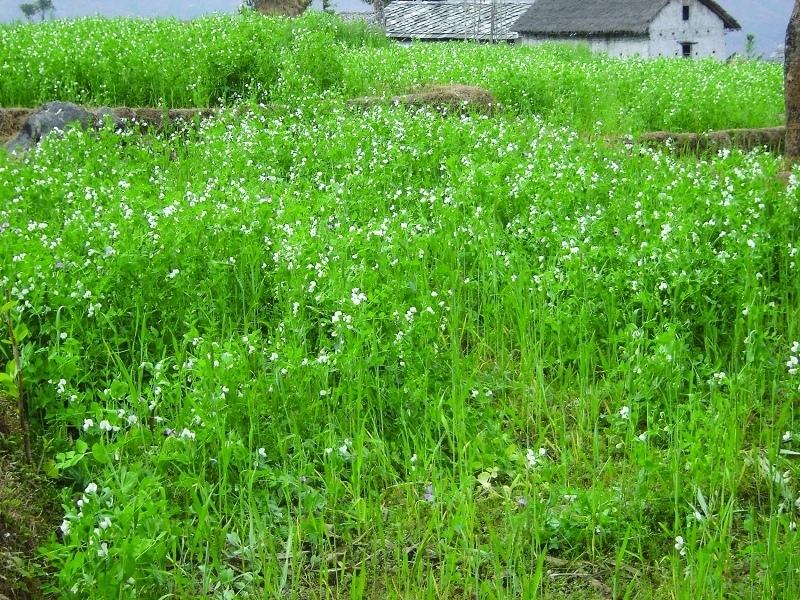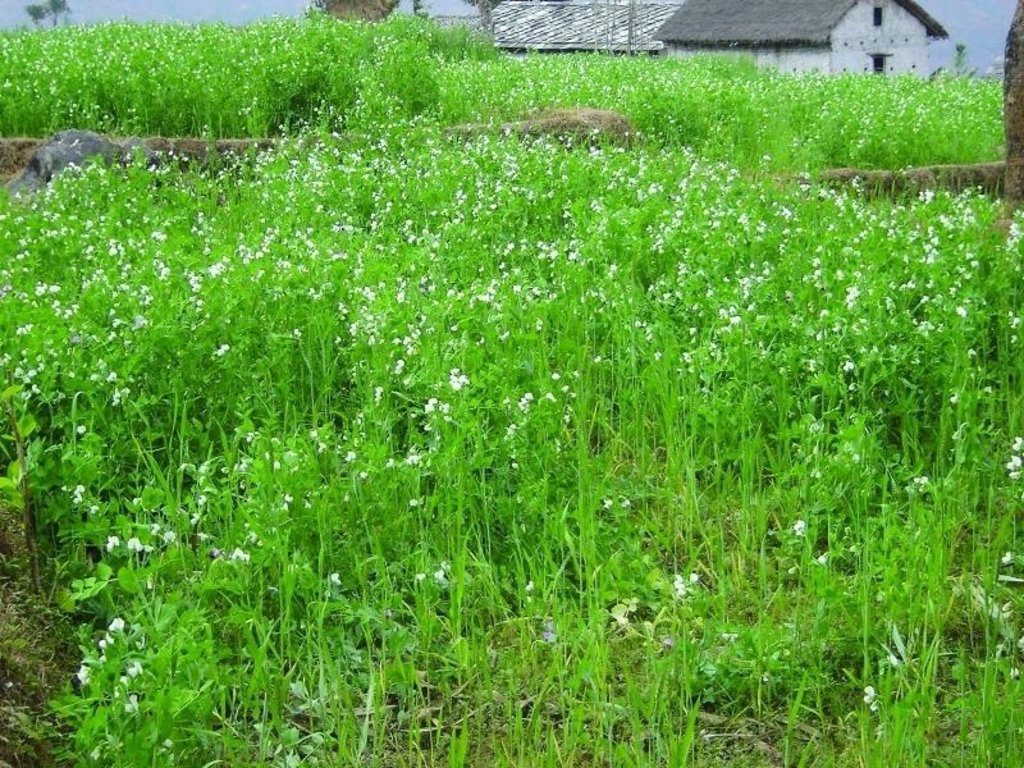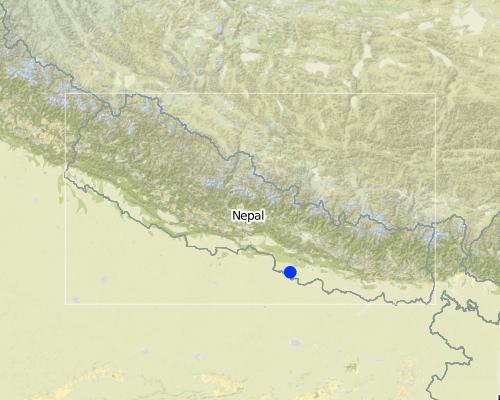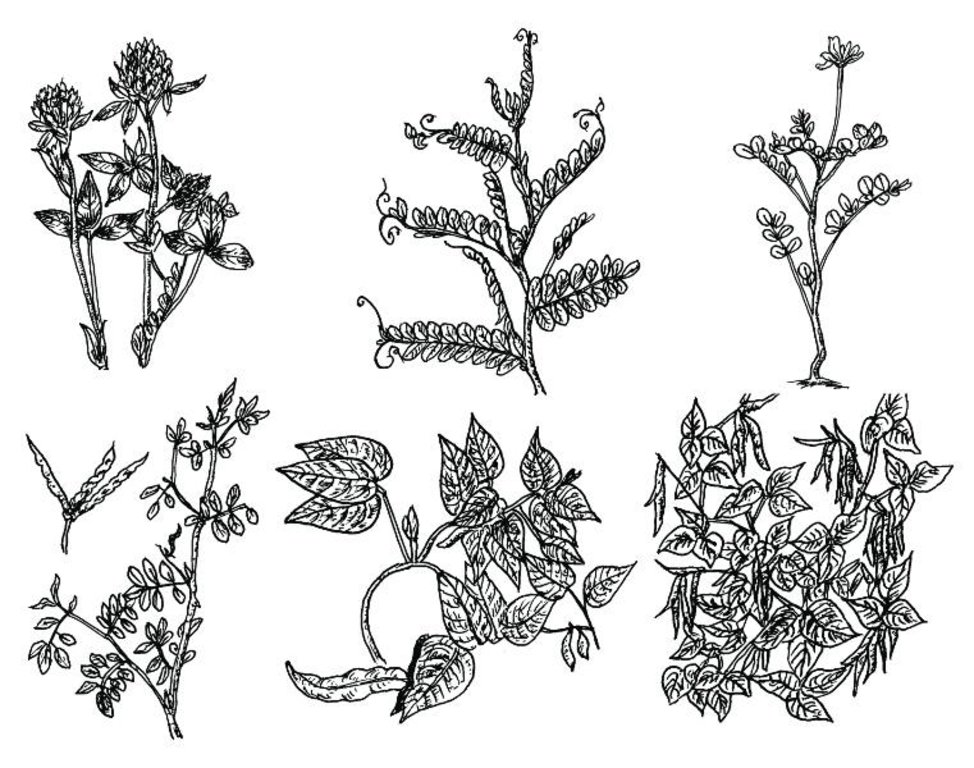Legume integration [เนปาล]
- ผู้สร้างสรรค์:
- การอัพเดท:
- ผู้รวบรวม: Richard Allen
- ผู้เรียบเรียง: –
- ผู้ตรวจสอบ: David Streiff
Bali pranali ma kosebali samabesh
technologies_1753 - เนปาล
ดูส่วนย่อย
ขยายทั้งหมด ย่อทั้งหมด1. ข้อมูลทั่วไป
1.2 รายละเอียดที่ติดต่อได้ของผู้รวบรวมและองค์กรที่เกี่ยวข้องในการประเมินและการจัดเตรียมทำเอกสารของเทคโนโลยี
ผู้เชี่ยวชาญ SLM:
Director
+977 1 5520314
Soil Management Directorate, Department of Agriculture
เนปาล
ผู้เชี่ยวชาญ SLM:
Team Leader
+977 1 5543591
Sustainable Soil Management Programme
เนปาล
ชื่อของโครงการซึ่งอำนวยความสะดวกในการทำเอกสารหรือการประเมินเทคโนโลยี (ถ้าเกี่ยวข้อง)
Sustainable Soil Management Programme, Nepal (SSMP)ชื่อขององค์กรซึ่งอำนวยความสะดวกในการทำเอกสารหรือการประเมินเทคโนโลยี (ถ้าเกี่ยวข้อง)
Department of Agriculture, Soil Management Directorate, Hariharbhawan Lalitpur (doasoil) - เนปาลชื่อขององค์กรซึ่งอำนวยความสะดวกในการทำเอกสารหรือการประเมินเทคโนโลยี (ถ้าเกี่ยวข้อง)
HELVETAS (Swiss Intercooperation)1.3 เงื่อนไขการใช้ข้อมูลที่ได้บันทึกผ่านทาง WOCAT
วันที่เก็บรวบรวมข้อมูล(ภาคสนาม) :
11/05/2008
ผู้รวบรวมและวิทยากรหลักยอมรับเงื่อนไขเกี่ยวกับการใช้ข้อมูลที่ถูกบันทึกผ่านทาง WOCAT:
ใช่
1.5 อ้างอิงไปที่แบบสอบถามเรื่องแนวทาง SLM

Farmer field schools on integrated plant nutrient systems [เนปาล]
Participatory and collaborative learning through the farmer field school approach
- ผู้รวบรวม: Richard Allen
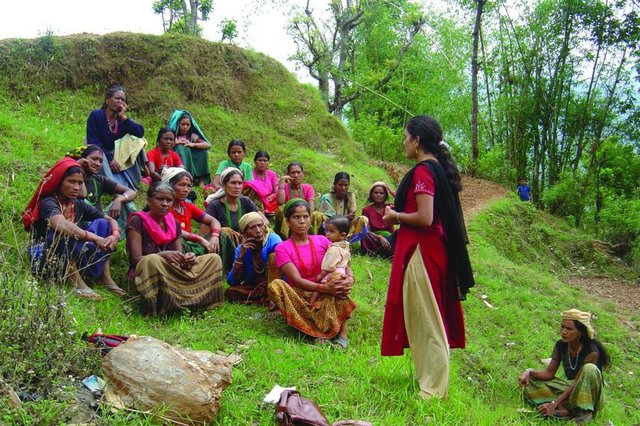
Farmer-led experimentation [เนปาล]
Participatory technology testing and adaptation through farmer-led experiments
- ผู้รวบรวม: Richard Allen

Farmer-to-farmer diffusion [เนปาล]
Wider diffusion of sustainable soil management technologies through a demand responsive farmer-to-farmer diffusion approach
- ผู้รวบรวม: Richard Allen
2. การอธิบายลักษณะของเทคโนโลยี SLM
2.1 การอธิบายแบบสั้น ๆ ของเทคโนโลยี
คำจำกัดความของเทคโนโลยี:
Integration of leguminous crops as intercrops on terrace risers or as relay crops
2.2 การอธิบายแบบละเอียดของเทคโนโลยี
คำอธิบาย:
Legumes are widely grown across the hills of Nepal, with the most common being soybean, lentils, black gram, cow pea, beans, horse gram, field peas, and rice bean. They are mostly intercropped or relay cropped with cereals such as maize, millet, and rice. They are also planted on the edges of terraces and rice paddy bunds. Depending on the species, they may be grown in rain-fed or irrigated fields during the winter or summer seasons.
The majority of the legumes grown by farmers are used for food or as a cash crop. The planting of fodder legumes has become more popular with the expansion of stall-feeding and the development of a dairy industry. The planting of legumes, with the main objective of improving soil fertility is a more recent development in Nepal’s hills.
Nitrogen is the main plant nutrient element and is usually applied through commercial fertiliser where available. Legumes fix atmospheric nitrogen through bacterial nodules on their roots, then nitrogen subsequently becomes available to the following crops. It is important, therefore, not to uproot the legume crop during harvesting - it should be harvested by cutting the above ground parts leaving the roots (and the nodules) in the soil. The crop residues can be fed to livestock, used as animal bedding, applied as green manure directly to fields, or incorporated in compost. In this way most of the nitrogen that was fixed by the legume crop is returned to the soil.
Details about the different legume species and their different characteristics and uses are described in detail in SSMP, PARDYP and SSD-NARC (2000).
2.3 รูปภาพของเทคโนโลยี
2.5 ประเทศภูมิภาค หรือสถานที่ตั้งที่เทคโนโลยีได้นำไปใช้และได้รับการครอบคลุมโดยการประเมินนี้
ประเทศ:
เนปาล
ข้อมูลจำเพาะเพิ่มเติมของสถานที่ตั้ง :
Midhills districts of Nepal
Map
×3. การจัดประเภทของเทคโนโลยี SLM
3.1 วัตถุประสงค์หลักของเทคโนโลยี
- improve soil fertility
3.2 ประเภทของการใช้ที่ดินในปัจจุบันที่ได้นำเทคโนโลยีไปใช้

พื้นที่ปลูกพืช
- การปลูกพืชล้มลุกอายุปีเดียว
แสดงความคิดเห็น:
Major land use problems (compiler’s opinion): Intensifying cultivation practices with either 1) inadequate application of fertilisers leading to a decline in soil
fertility and the mining of soil nutrients or 2) the application of too much fertiliser causing environmental problems
through excessive leaching, losses of fertiliser in surface runoff, and consequent eutrophication or nitrification of streams,
ponds, or groundwater.
3.4 กลุ่ม SLM ที่ตรงกับเทคโนโลยีนี้
- การจัดการความอุดมสมบรูณ์ของดินแบบผสมผสาน
- การปรับปรุงพันธุ์พืชหรือพันธุ์สัตว์ต่าง ๆ
3.5 กระจายตัวของเทคโนโลยี
ระบุการกระจายตัวของเทคโนโลยี:
- กระจายไปอย่างสม่ำเสมอในพื้นที่
3.6 มาตรการ SLM ที่ประกอบกันเป็นเทคโนโลยี

มาตรการจัดการพืช
- A2: อินทรียวัตถุในดิน/ความอุดมสมบูรณ์ในดิน
3.7 รูปแบบหลักของการเสื่อมโทรมของที่ดินที่ได้รับการแก้ไขโดยเทคโนโลยี

การเสื่อมโทรมของดินทางด้านเคมี
- Cn (Fertility decline): ความอุดมสมบูรณ์และปริมาณอินทรียวัตถุในดินถูกทำให้ลดลงไป (ไม่ได้เกิดจากสาเหตุการกัดกร่อน)
3.8 การป้องกัน การลดลง หรือการฟื้นฟูความเสื่อมโทรมของที่ดิน
ระบุเป้าหมายของเทคโนโลยีกับความเสื่อมโทรมของที่ดิน:
- ลดความเสื่อมโทรมของดิน
4. ข้อมูลจำเพาะด้านเทคนิค กิจกรรมการนำไปปฏิบัติใช้ ปัจจัยนำเข้า และค่าใช้จ่าย
4.1 แบบแปลนทางเทคนิคของเทคโนโลยี
4.2 ข้อมูลจำเพาะด้านเทคนิคและการอธิบายแบบแปลนทางเทคนิค
A number of species are presented
in the legume integration decision
support guide (SSMP, PARDYP, SSDNARC 2000). Here only a selection of useful legume species are presented (from top left corner to lower right corner):
- red clover (Trifolium pratense)
- hairy vetch (Vicia villosa Roth)
- Chinese milk vetch (Astragalus sinicus)
- rice bean (Vigna umbellata)
- velvet bean (Mucuna pruriens)
- tephrosia (Tephrosia spp.
Technical knowledge required for field staff / advisors: low
Technical knowledge required for land users: low
Main technical functions: increase in soil fertility (nitrogen in particular), increase in soil productivity & decrease in soil erosionon terrace bunds, nutritius and high value crops
Secondary technical functions: fodder and green manure availability & income
4.3 ข้อมูลทั่วไปเกี่ยวกับการคำนวณปัจจัยนำเข้าและค่าใช้จ่าย
ให้ระบุว่าค่าใช้จ่ายและปัจจัยนำเข้าได้รับการคำนวณอย่างไร:
- ต่อหน่วยเทคโนโลยี
ระบุสกุลเงินที่ใช้คำนวณค่าใช้จ่าย:
- ดอลลาร์สหรัฐ
ระบุค่าเฉลี่ยของค่าจ้างในการจ้างแรงงานต่อวัน:
2.00
4.5 ค่าใช้จ่ายของปัจจัยนำเข้าที่จำเป็นสำหรับการจัดตั้ง
| ปัจจัยนำเข้า | หน่วย | ปริมาณ | ค่าใช้จ่ายต่อหน่วย | ค่าใช้จ่ายทั้งหมดต่อปัจจัยนำเข้า | %ของค่าใช้จ่ายที่ก่อให้เกิดขึ้นโดยผู้ใช้ที่ดิน | |
|---|---|---|---|---|---|---|
| แรงงาน | Labour | Persons/day | 2.5 | 2.0 | 5.0 | |
| วัสดุด้านพืช | Seeds | unit | 1.0 | 1.5 | 1.5 | |
| ค่าใช้จ่ายทั้งหมดของการจัดตั้งเทคโนโลยี | 6.5 | |||||
4.6 การบำรุงรักษาสภาพหรือกิจกรรมที่เกิดขึ้นเป็นประจำ
| กิจกรรม | ประเภทของมาตรการ | ช่วงระยะเวลา/ความถี่ | |
|---|---|---|---|
| 1. | Depending on the type of farm niche - broadcast, line sow, or spot | จัดการพืช |
4.7 ค่าใช้จ่ายของปัจจัยนำเข้าและกิจกรรมที่เกิดขึ้นเป็นประจำที่ต้องการการบำรุงรักษา (ต่อปี)
แสดงความคิดเห็น:
Cost as in January 2007
5. สิ่งแวดล้อมทางธรรมชาติและของมนุษย์
5.1 ภูมิอากาศ
ฝนประจำปี
- < 250 ม.ม.
- 251-500 ม.ม.
- 501-750 ม.ม.
- 751-1,000 ม.ม.
- 1,001-1,500 ม.ม.
- 1,501-2,000 ม.ม.
- 2,001-3,000 ม.ม.
- 3,001-4,000 ม.ม.
- > 4,000 ม.ม.
ข้อมูลจำเพาะ/ความคิดเห็นเรื่องปริมาณน้ำฝน:
Annual rainfall: Also 2000-3000 mm
เขตภูมิอากาศเกษตร
- ชื้น
Thermal climate class: subtropics
5.2 สภาพภูมิประเทศ
ค่าเฉลี่ยความลาดชัน:
- ราบเรียบ (0-2%)
- ลาดที่ไม่ชัน (3-5%)
- ปานกลาง (6-10%)
- เป็นลูกคลื่น (11-15%)
- เป็นเนิน (16-30%)
- ชัน (31-60%)
- ชันมาก (>60%)
ธรณีสัณฐาน:
- ที่ราบสูง/ที่ราบ
- สันเขา
- ไหล่เขา
- ไหล่เนินเขา
- ตีนเนิน
- หุบเขา
ระดับความสูง:
- 0-100 เมตร
- 101-500 เมตร
- 501-1,000 เมตร
- 1,001-1,500 เมตร
- 1,501-2,000 เมตร
- 2,001-2,500 เมตร
- 2,501-3,000 เมตร
- 3,001-4,000 เมตร
- > 4,000 เมตร
ความคิดเห็นและข้อมูลจำเพาะเพิ่มเติมเรื่องสภาพภูมิประเทศ:
Slopes on average:Also moderate (6-10%), rolling (11-15%) and hilly (16-30%)
Landforms: Also footslopes
Altitudinal zone: Also 1000-1500 m a.s.l., 1500-2000 m a.s.l. and 2000-2500 m a.s.l.
5.6 ลักษณะของผู้ใช้ที่ดินที่นำเทคโนโลยีไปปฏิบัติใช้
แนวทางการตลาดของระบบการผลิต:
- เพื่อการยังชีพ (หาเลี้ยงตนเอง)
- ทำการค้า/การตลาด
เป็นรายบุคคล/ครัวเรือน:
- เป็นรายบุคคล/ครัวเรือน
ระบุลักษณะอื่นๆที่เกี่ยวข้องของผู้ใช้ที่ดิน:
Off-farm income specification: In most farm households, off-farm income plays at least a minor and increasingly a major role. Occasional opportunities for off-farm income present themselves in the form of daily labour wages. Some households’ members receive regular salaries whilst an increasing number of Nepalis are working in India, the Middle East, Malaysia and elsewhere and sending remittance incomes home.
5.7 พื้นที่เฉลี่ยของที่ดินที่เป็นเจ้าของหรือเช่าโดยผู้ใช้ที่ดินที่นำเทคโนโลยีไปปฏิบัติใช้
- < 0.5 เฮกตาร์
- 0.5-1 เฮกตาร์
- 1-2 เฮกตาร์
- 2-5 เฮกตาร์
- 5-15 เฮกตาร์
- 15-50 เฮกตาร์
- 50-100 เฮกตาร์
- 100-500 เฮกตาร์
- 500-1,000 เฮกตาร์
- 1,000-10,000 เฮกตาร์
- >10,000 เฮกตาร์
5.8 กรรมสิทธิ์ในที่ดิน สิทธิในการใช้ที่ดินและสิทธิในการใช้น้ำ
กรรมสิทธิ์ในที่ดิน:
- รายบุคคล ไม่ได้รับสิทธิครอบครอง
- รายบุคคล ได้รับสิทธิครอบครอง
สิทธิในการใช้ที่ดิน:
- เช่า
- รายบุคคล
แสดงความคิดเห็น:
sharecropping between owner and tenant
6. ผลกระทบและสรุปคำบอกกล่าว
6.1 ผลกระทบในพื้นที่ดำเนินการ (On-site) จากการใช้เทคโนโลยี
ผลกระทบทางด้านเศรษฐกิจและสังคม
รายได้และค่าใช้จ่าย
ค่าใช่จ่ายของปัจจัยการผลิตทางการเกษตร
แสดงความคิดเห็น/ระบุ:
Reduced expenses for nitrogen fertilizers
ผลกระทบทางด้านเศรษฐกิจและสังคมอื่น ๆ
Livestock fodder nutritiousness
Value and nutritiousness of crops
Crop in terms of main yield
ผลกระทบด้านนิเวศวิทยา
ดิน
การสูญเสียดิน
อินทรียวัตถุในดิน/ต่ำกว่าดินชั้น C
ความหลากหลายทางชีวภาพของพืชและสัตว์
การจัดการศัตรูพืชและโรคพืช
แสดงความคิดเห็น/ระบุ:
Highly susceptible to diseases and pests
ผลกระทบด้านนิเวศวิทยาอื่น ๆ
Application of fertilizer
6.2 ผลกระทบนอกพื้นที่ดำเนินการ (Off-site) จากการใช้เทคโนโลยี
การเกิดมลพิษในน้ำบาดาลหรือแม่น้ำ
แสดงความคิดเห็น/ระบุ:
Reduced nutrient flux into water bodies
Dependence on outside
6.4 การวิเคราะห์ค่าใช้จ่ายและผลประโยชน์ที่ได้รับ
ผลประโยชน์ที่ได้รับเปรียบเทียบกับค่าใช้จ่ายในการจัดตั้งเป็นอย่างไร (จากมุมมองของผู้ใช้ที่ดิน)
ผลตอบแทนระยะสั้น:
ด้านบวก
ผลตอบแทนระยะยาว:
ด้านบวก
ผลประโยชน์ที่ได้รับเปรียบเทียบกับค่าใช้จ่ายในการบำรุงรักษาหรือต้นทุนที่เกิดขึ้นซ้ำอีก เป็นอย่างไร (จากมุมมองของผู้ใช้ที่ดิน)
ผลตอบแทนระยะสั้น:
ด้านบวก
ผลตอบแทนระยะยาว:
ด้านบวก
แสดงความคิดเห็น:
On average a benefi t of US$ 40 to 50 per ropani can be expected from the production of legume species
6.5 การปรับตัวของเทคโนโลยี
แสดงความคิดเห็น:
Comments on spontaneous adoption: About 80% of participating farmers used/had adopted the technolog. It has also been adopted by farmers who have not directly participated in SSMP activities.
6.7 จุดแข็ง / ข้อได้เปรียบ / โอกาสของเทคโนโลยี
| จุดแข็ง / ข้อได้เปรียบ / โอกาสในทัศนคติของผู้รวบรวมหรือวิทยากรหลัก |
|---|
| Cost effective in terms of inputs and management practices in comparison with other commodities |
| Needs less agronomic practices and care (i.e. can be cultivated in zero or reduced tillage) |
| Has multiple uses: food crop, feed crop, fodder, soil building |
| Can be integrated in varying niches on farms and therefore does not need additional land |
| Rich indigenous knowledge exists |
6.8 จุดอ่อน / ข้อเสียเปรียบ / ความเสี่ยงของเทคโนโลยีและวิธีการแก้ไข
| จุดอ่อน / ข้อเสียเปรียบ / ความเสี่ยงในทัศนคติของผู้รวบรวมหรือวิทยากรหลัก | มีวิธีการแก้ไขได้อย่างไร |
|---|---|
| Highly vulnerable to diseases and pests | Skip planting time (i.e. preponing planting of crops to get around life cycle of pests) , use location specifi c species, resistant varieties |
| Very susceptible to waterlogging | Only plant in well-drained soils |
| In high fertility conditions, nitrogen fixing rhizobium does not work leading to less nitrogen fixation | For very specifi c and new species, the soil needs to be inoculated with the correct strain of bacteria |
| Legumes generally do not respond to nitrogen fertiliser | Do not apply nitrogen fertiliser to legumes |
7. การอ้างอิงและการเชื่อมต่อ
7.2 การอ้างอิงถึงสิ่งตีพิมพ์
หัวข้อ, ผู้เขียน, ปี, หมายเลข ISBN:
SSMP (2005) Legume Integration Manual (in Nepali). Kathmandu: Sustainable Soil Management Programme
ชื่อเรื่อง ผู้เขียน ปี ISBN:
SSMP
หัวข้อ, ผู้เขียน, ปี, หมายเลข ISBN:
SSMP; PARDYP; SSD-NARC (2000) LegumeIntegration into Hill Farming Systems, Decision Support Guide Kathmandu: Sustainable Soil Management Programme, People and Resource Dynamics Project and Soil Science Division-Nepal Agricultural Research Council
ชื่อเรื่อง ผู้เขียน ปี ISBN:
SSMP
ลิงก์และโมดูล
ขยายทั้งหมด ย่อทั้งหมดลิงก์

Farmer field schools on integrated plant nutrient systems [เนปาล]
Participatory and collaborative learning through the farmer field school approach
- ผู้รวบรวม: Richard Allen

Farmer-led experimentation [เนปาล]
Participatory technology testing and adaptation through farmer-led experiments
- ผู้รวบรวม: Richard Allen

Farmer-to-farmer diffusion [เนปาล]
Wider diffusion of sustainable soil management technologies through a demand responsive farmer-to-farmer diffusion approach
- ผู้รวบรวม: Richard Allen
โมดูล
ไม่มีโมดูล


